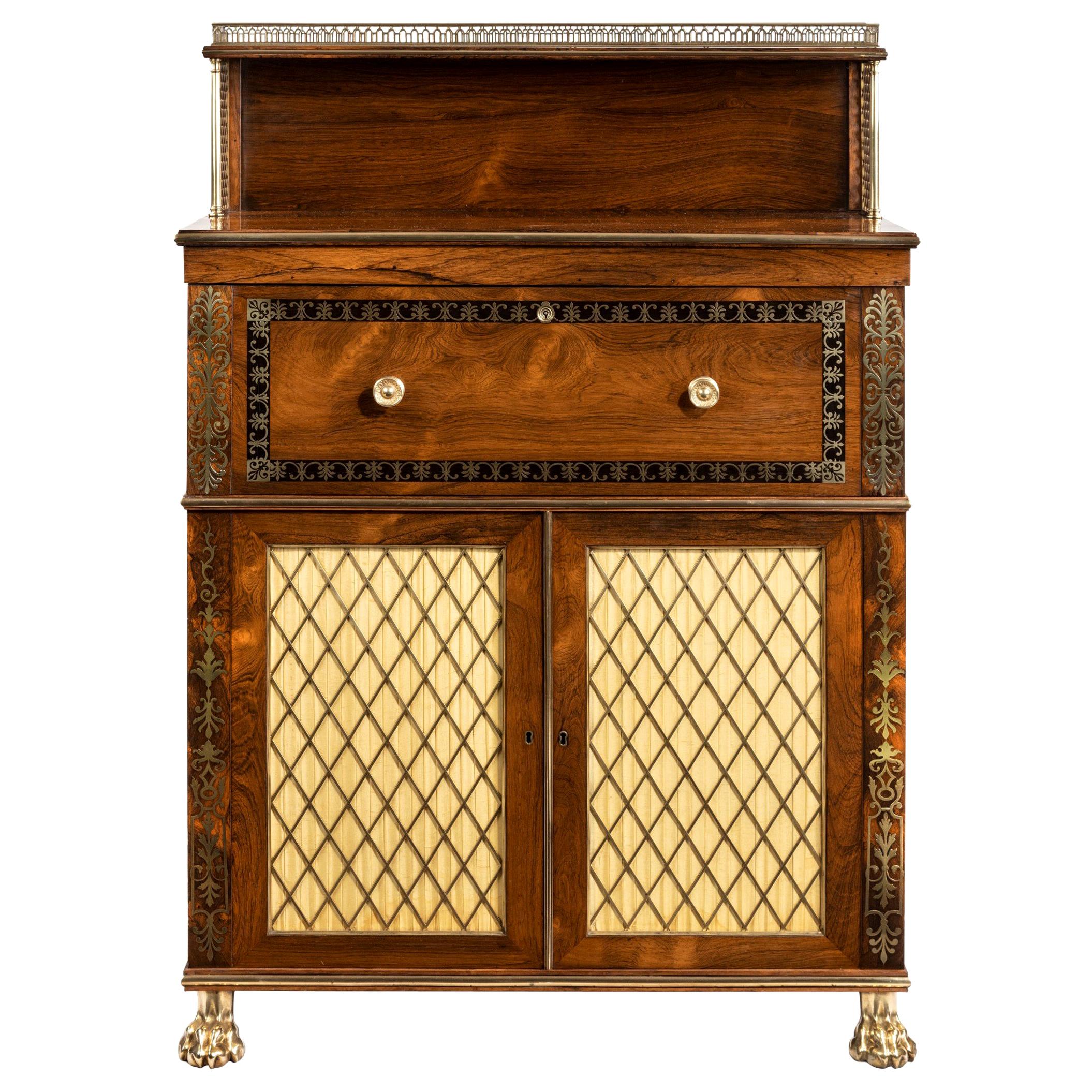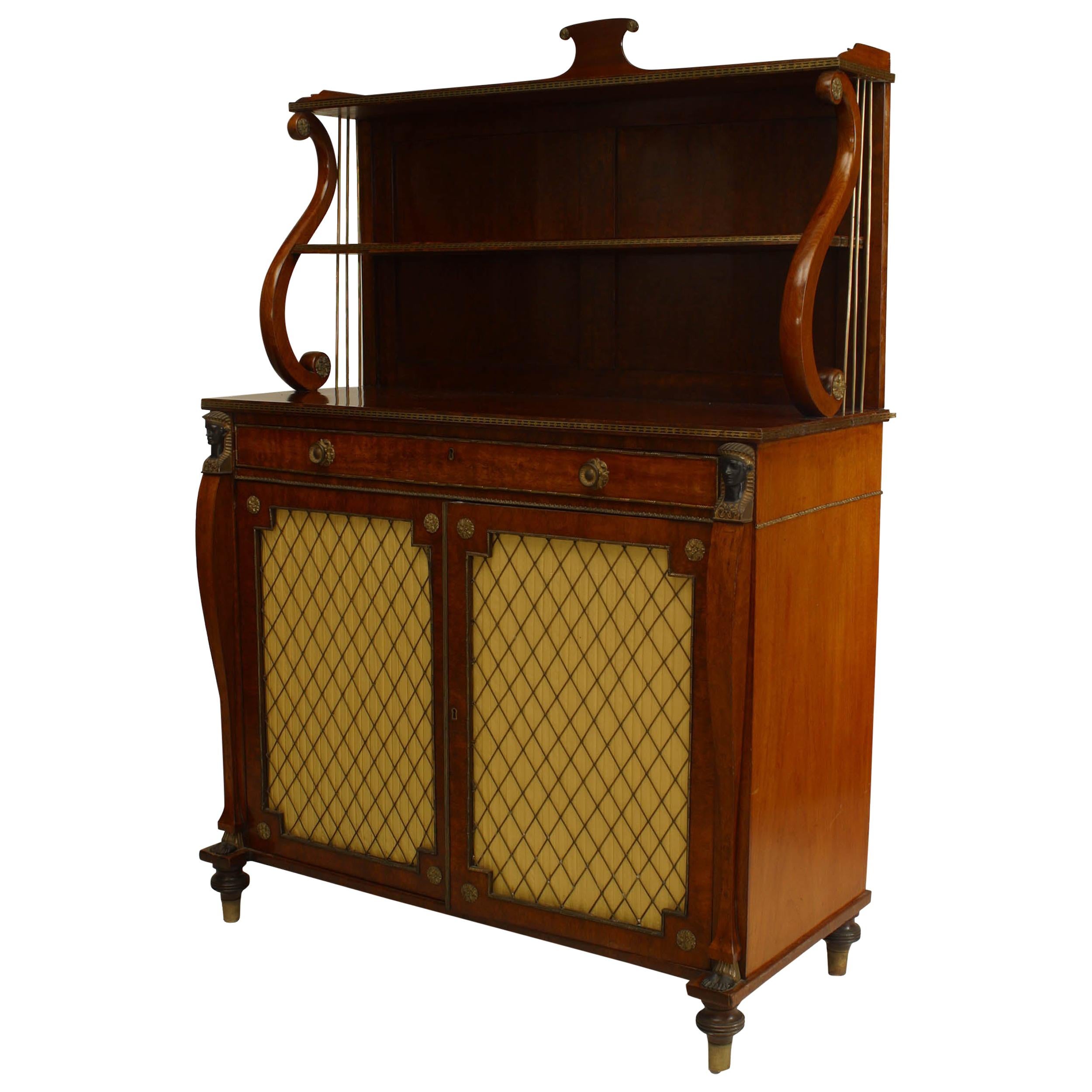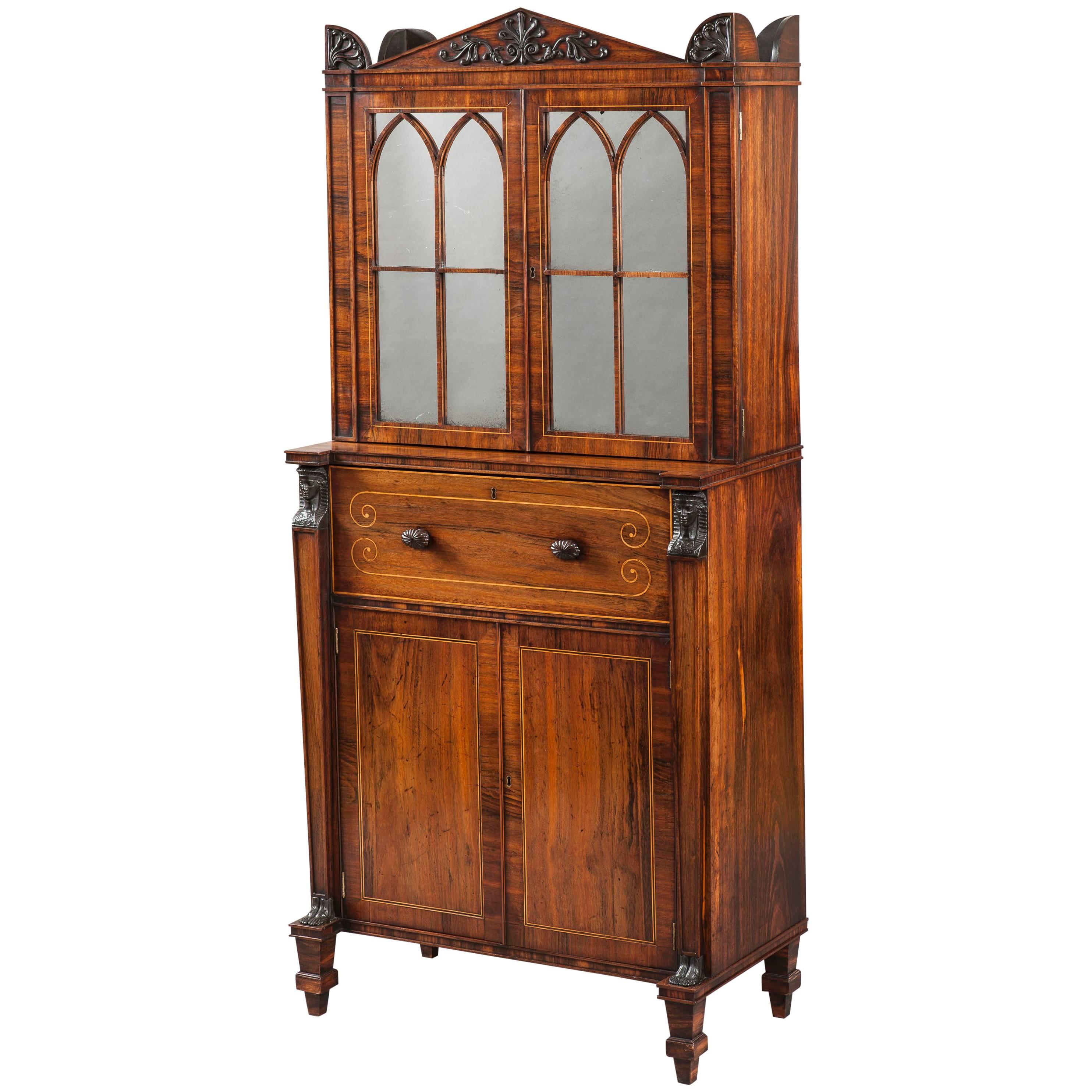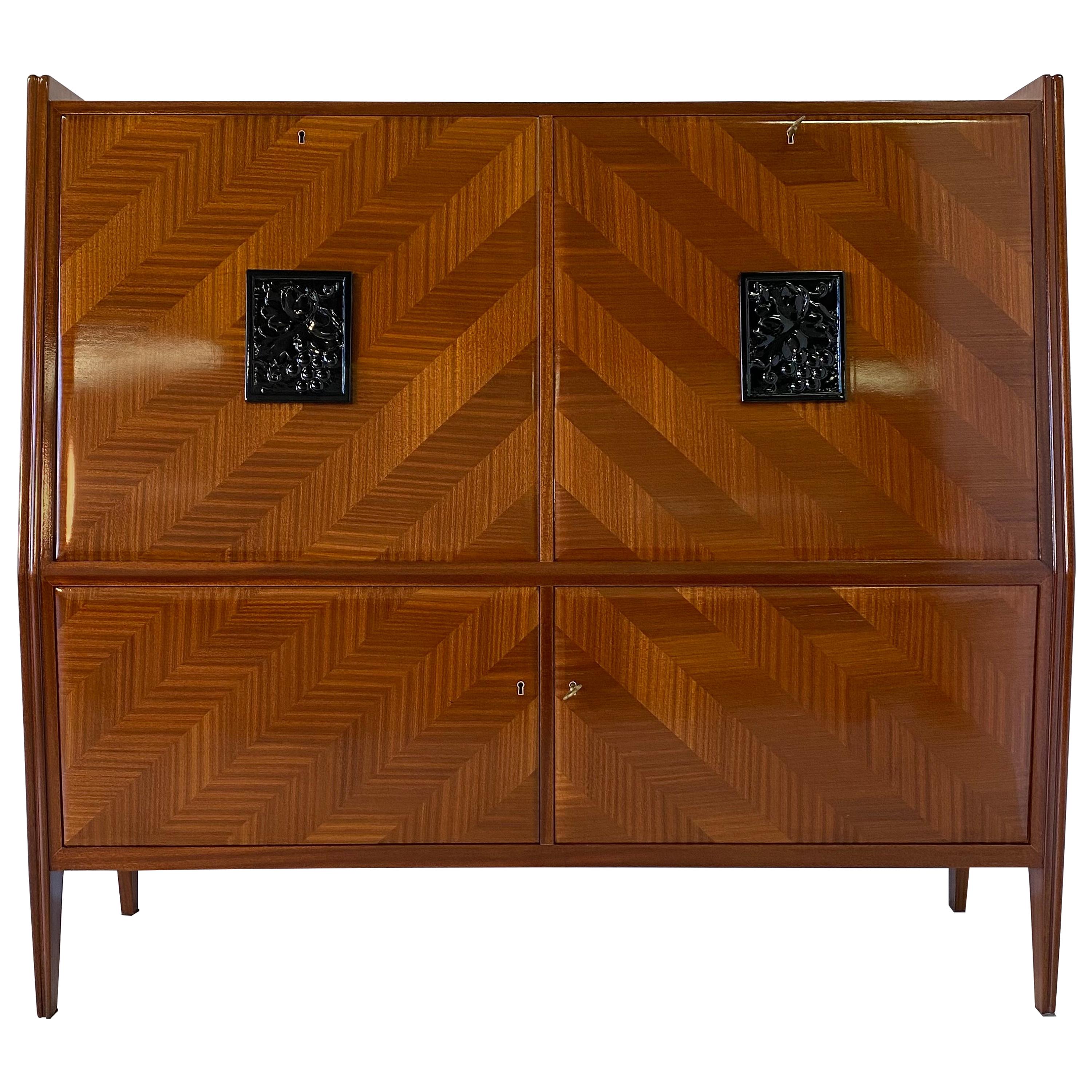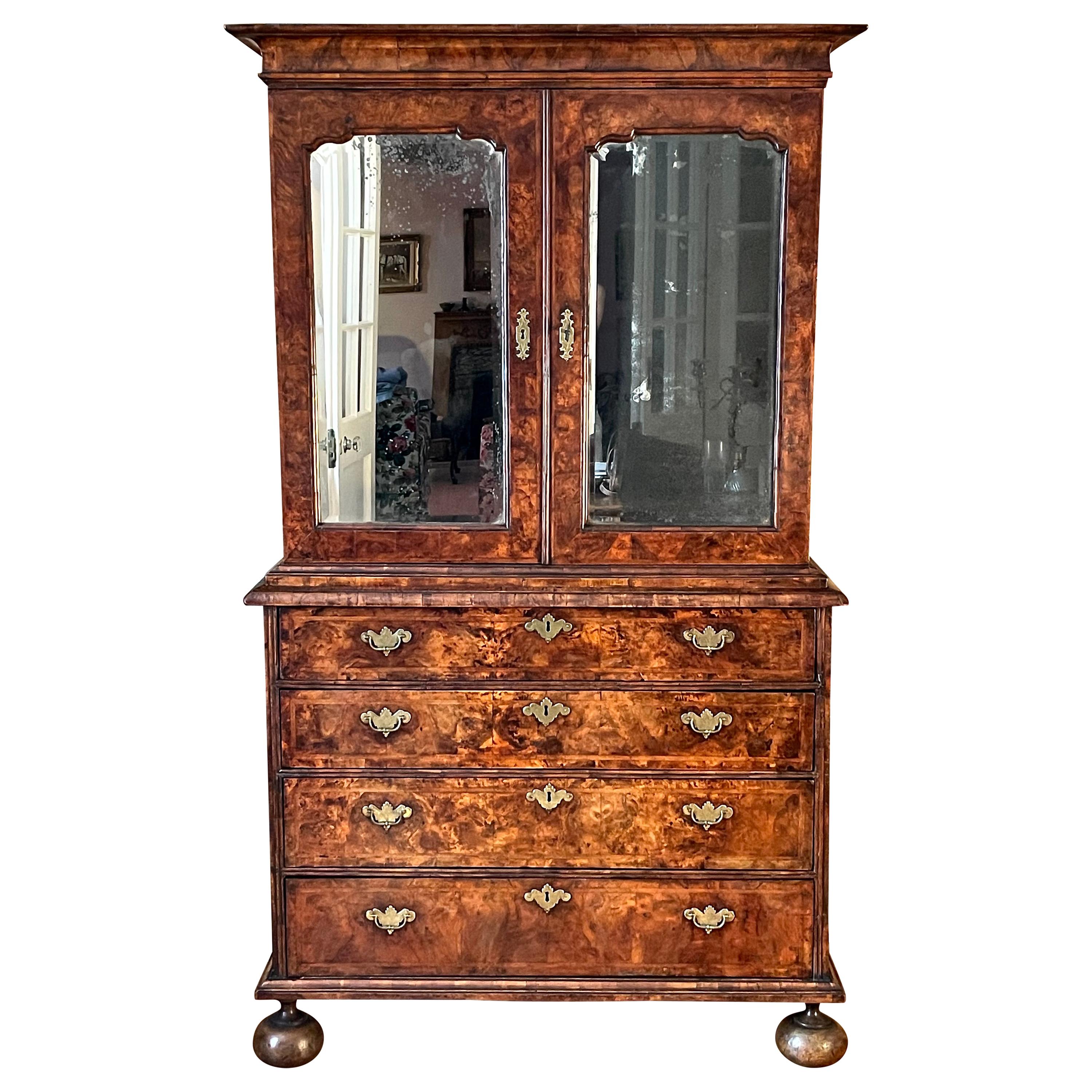Items Similar to Regency Rosewood Secretaire Side Cabinet/Chiffoneer
Want more images or videos?
Request additional images or videos from the seller
1 of 14
Regency Rosewood Secretaire Side Cabinet/Chiffoneer
About the Item
A superior quality and unusual Regency rosewood Side Cabinet, the top drawer with fold-down, leather-lined front, fully fitted with drawers and pigeon holes. below are a pair of silk-lined cupboard doors with original and elaborate brass grills. Standing on well-carved lions paw feet with scrolled heels.
- Dimensions:Height: 35.83 in (91 cm)Width: 25.6 in (65 cm)Depth: 17.33 in (44 cm)
- Style:Regency (Of the Period)
- Materials and Techniques:
- Place of Origin:
- Period:
- Date of Manufacture:circa 1820
- Condition:Replacements made: Replacement silk lining to the doors and replcaed velvet writing surface. Wear consistent with age and use.
- Seller Location:Folkestone, GB
- Reference Number:
About the Seller
No Reviews Yet
Vetted Seller
These experienced sellers undergo a comprehensive evaluation by our team of in-house experts.
1stDibs seller since 2022
13 sales on 1stDibs
- ShippingRetrieving quote...Ships From: Faversham, United Kingdom
- Return PolicyA return for this item may be initiated within 14 days of delivery.
More From This SellerView All
- Regency Rosewood ChiffonierLocated in Folkestone, GBA good quality early 19th century Regency period rosewood Chiffonier, the beaded edge, galleried superstructure raised on 'S' scrolled supports abo...Category
Antique Early 19th Century English Regency Sideboards
MaterialsRosewood
- Regency Rosewood Breakfront Side Cabinet / ChiffonierLocated in Folkestone, GBA fine quality and very stylish late Regency rosewood inverted breakfront side cabinet with two raised shelves supported on turned columns and ...Category
Antique Early 19th Century European Regency Sideboards
MaterialsMahogany
- Regency Mahogany Sarcophagus CellaretteLocated in Folkestone, GBA fine quality Regency period, figured mahogany cellarette, the flat top with slightly raised central panel, opening to reveal a later baize-lined interior. The tapered body and pane...Category
Antique Early 19th Century English Regency Cabinets
MaterialsMahogany
- Miniature Rosewood Wellington ChestLocated in Folkestone, GBA charming early 19th century rosewood five drawer miniature Wellington chest with a stepped rectangular top above five graduated drawers wh...Category
Antique Early 19th Century European Regency Cabinets
MaterialsRosewood
- Regency Wine Cooler/Cellarette Attributed to GillowsBy Gillows of Lancaster & LondonLocated in Folkestone, GBAn exceptional and outstanding quality Regency period sarcophagus shaped mahogany wine cooler attributed to Gillows, constructed in the most beautifully figured mahogany and carved a...Category
Antique Early 19th Century English Regency Cabinets
MaterialsMahogany
- Regency Rosewood CanterburyLocated in Folkestone, GBA very fine quality Regency period rosewood Canterbury of classic shape and form with four divisions and a central carrying handle above a drawer a...Category
Antique Early 18th Century English Regency Magazine Racks and Stands
MaterialsRosewood
You May Also Like
- Regency Brass-Inlaid Rosewood Secretaire CabinetLocated in Lymington, HampshireA Regency brass-inlaid rosewood secretaire cabinet, the rectangular top with a pierced galleried shelf with trellis work on the sides, above a secretaire drawer, banded with brass pa...Category
Antique 1810s English Regency Cabinets
MaterialsBrass
- English Regency Rosewood SecretaireLocated in New York, NYEnglish Regency rosewood secretaire cabinet with two upper shelves supported by a lyre form over a secretaire drawer fitted with a leather wri...Category
Antique Mid-19th Century English Regency Secretaires
MaterialsRosewood
- English Regency Period Secrétaire Cabinet with Egyptian MotifsBy George OakleyLocated in London, GBA secrétaire cabinet of the Regency period Firmly attributed to George Oakley. Constructed in a finely faded and patinated goncalo alvez, having holly and purple heart stringing;...Category
Antique 19th Century English Regency Cabinets
MaterialsPurpleheart, Satinwood, Holly
- King George I Ambassadorial Secrétaire-CabinetLocated in New Orleans, LAThis highly important secrétaire-cabinet was crafted for and specially ordered by King George I for the British Ambassador to Russia. From its craftsmanship and materials to its exceptional artistry, it is a work of royal and historic significance that exudes power in each and every detail. The broken pediment at its apex features the simplified royal coat of arms bearing the king’s crown, while the interior is adorned by portraits of the British Royal Family. Placed within the ambassador’s St. Petersburg home, this entirely unique piece of furniture would have been a potent reminder of England's grandeur and political importance. Relations between England and Russia during this period were at an all-time high. Peter the Great had traveled to England in 1698 as part of his widely known “Grand Embassy” tour, wherein he attempted to gain foreign support against the Ottoman Empire. He spent a period of nearly four months there, meeting with King William III and his court on numerous occasions. Noted academic Arthur MacGregor wrote concerning the impact of the trip, “For two decades following Peter's visit, British influence in Russia reached a peak. It manifested itself in social custom, in craft practice and in ships and naval organization... it reached a significant sector of the population before relations cooled once again and the two nations pulled back from this era of unprecedented cordiality.” First and foremost, however, it is a reminder of British might and influence. By the reign of King George I, England had come into its own as a world power. Unique in its design, this cabinet is a reflection of the country’s might. It is crafted from the highest-quality solid walnut and burr walnut adorned by gilded lock plates and engraved hinges. The presence of ormolu at its apex and lining the doors was a rarity for this period, and its addition makes manifest the importance of the design. The outer doors open to reveal multiple interiors, including fifteen separate drawers around a central cupboard; the cupboard doors each bear mezzotint portraits of George I and his father, Ernest Augustus, Elector of Hanover. An etching after the portrait of George I dating to circa 1716 is in London’s Royal Academy. A second, inner pair of doors are adorned by mezzotints of the Prince and Princess of Wales (later Queen Caroline and George II), which are both after portraits by Sir Godfrey Kneller dated 1716 in the Royal Collection. A final portrait is revealed on the very interior of the cabinet, where a mezzotint of Frederick, Anne, Amelia and Caroline, children of the Prince of Wales, resides. An etching (circa 1715-1720) after this portrait can be found in the National Portrait Gallery (London). Apart from its abundance of royal portraiture, the cabinet features stunning painted decoration, including floral designs as well as clouds, birds and trees in a bucolic motif reminiscent of Eden. Its lower portion is a study in both form and function, featuring a fitted secrétaire-drawer above three additional drawers for storage. The cabinet appears in The Shorter Dictionary of English Furniture by R. Edwards from 1964, a text that is regarded as the bible of British furniture design. Edwards describes it as a “writing cabinet...given by George I to the British Ambassador at the Russian court.” The cabinet was likely made for the 18th-century German diplomat and writer Friedrich Christian Weber, who represented English interests at the Russian court from 1714 until 1719. Although Weber’s tenure as ambassador was relatively short, while in St. Petersburg, he authored his account entitled Das veraenderte Russland (The Present State of Russia), which was published in three volumes in 1721, 1739 and 1740. It may, however, also have been made for George Douglas, 2nd Earl of Dumbarton, who served as ambassador alongside Weber in 1716. Diplomatic relations ceased between the two countries in 1721. In 1928, the cabinet appeared for sale at the International Exhibition of Antiques & Works of Art in Olympia. It had previously been in the collection of the Woltner family of Bordeaux, the celebrated vintners who owned the estate Château Laville Haut-Brion and produced wine of the same name. According to the family, Monsieur Woltner was given the cabinet as a gift from an aunt who lived in Russia for many years. After leaving the Woltner collection, the cabinet was acquired by William Berry...Category
Antique 18th Century English Georgian Secretaires
MaterialsBrass
- Italian Mahogany Secretaire Cabinet, 1950sLocated in Meda, MBPrecious cabinet secretaire produced in Italy in the 1950s, The whole cabinet is veneered in mahogany with a fine solid wood carving in the center of the two doors representing two b...Category
Vintage 1950s Italian Mid-Century Modern Cabinets
MaterialsMahogany, Maple
- Fine George I Burr Walnut Secretaire CabinetLocated in Lymington, GBA fine English George I-period burr (burl) walnut secretaire cabinet. Early-18th century, ca 1720. The top section separates from the base and opens to reveal numerous fitted drawers, behind doors with original bevelled arched mirror plates. The base contains a fall-front fitted secretaire with small drawers, two of which have secret drawers. Engraved mounts are contemporary if not original. All locks and cross-grained mouldings are original. Beautiful colour throughout with superb matched burr veneers within herringbone lines. Bun feet are original. Lined throughout in best quality English oak. The well-patinated green, gilt-tooled liner in the writing surface appears original. Very much in the style of John Old & William Ody. One of the most original early-18th century pieces of English walnut cabinet...Category
Antique 18th Century English George I Cabinets
MaterialsWalnut
